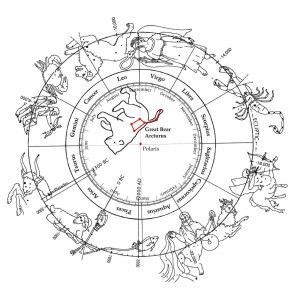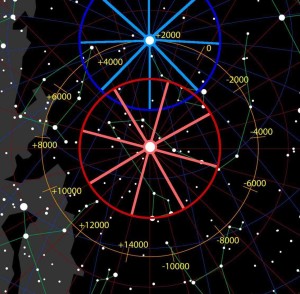ARTHUR, HIS ROUND TABLE AND THE ZODIAC
ARTHUR, HIS ROUND TABLE AND THE ZODIAC
By RALPH ELLIS
The round table is an integral part of the Arthurian Legend. So what is this table symbolism all about? Why is a humble table such an integral component of leadership, kingship, and the history of both Judaea and England?
The surprising answer to this, is that this famous table is not simply a table at all – in actual fact, the twelve-segmented layout of the Round Tables of both Jesus and Arthur came directly from the standard design of the Judaean zodiac.
A very good example of this zodiac imagery can be seen in the Hamat Teverya zodiac from Tiberias on the Sea of Galilee. So the Arthurian table was probably a real table, fabricated in wood, just like the Winchester Round Table, but it was marked out not simply with the names of the twelve knights/disciples, but also with the twelve signs of the zodiac that each knight/disciple was associated with. So when Simon is said to have been ‘hot tempered’, perhaps he sat at the segment of the table depicting Scorpio or Leo, and perhaps his official birthday was when Scorpio or Leo rose at the vernal equinox.
Thus the roundness of the Arthurian table was not simply a method of ensuring equality among the knights/disciples of the realm, as we have all been told, it was also a teaching aid that graphically described and explained the movement of the astrological constellations in the heavens above.
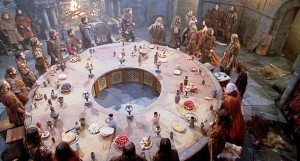
Fig 5.3 King Arthur and the Round Table. In this image, there is an empty space in the center of the table, but in reality it should have been occupied by Arthur/Jesus figure as the Sun (of) God, just as can be seen in the Hamat Teverya zodiac below. So Jesus/Arthur would not simply have been at the center of his court, he would also have been seated at the center of his table.
But do note the position of the kingly/Christly figure on the Hamat zodiac. Unlike the Winchester table the King/Christ/Sun figure is sitting in the center of the Hamat zodiac, because the Sun sits at the center of the constellations. And so this zodiac graphically demonstrates the true form that all of these Round Tables would have originally taken, with the Sun God (ie: Jesus, Joseph or Arthur as the ‘Suns of God’) sitting in the center of the zodiac/table surrounded by his twelve disciples/knights/constellations.
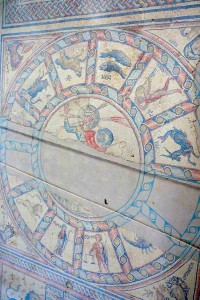
Fig 5.5 The first century Hamat Teverya zodiac at Tiberias on the Sea of Galilee – the template for the Round Table imagery of Arthurian legend. This zodiac was probably constructed in the early first century, during Jesus’ lifetime. Note that the central Sun-figure, Helios, carries a spherical blue Earth and so the form of the Earth was obviously well-known in this early era. And since the Sun is the main figure, with the Earth being held at arm’s length, then the form of the Heliocentric Solar System must also have been known.
Note that the head of Helios in this particular zodiac points at the join between the constellations of Aries and Pisces, a position that precisely marks the year AD 10, and so this zodiac is most definitely an early 1st century construction or depiction. This is one reason why Jesus was such an important prince, because he was born at the beginning of the new Great Month, the new precessional era when Aries changed to Pisces.
This was an auspicious moment in the precessional astrological calendar, as each month lasts for about 2,150 years, and so the Persian Magi would have been searching for a special king (a messiah or christ) who was born at this time. That king was the biblical Jesus, and so he was portrayed on this zodiac as Helios, the Sun (of) God, standing at the center of the zodiac and pointing at the start of the new Great Month, which lies between Aries and Pisces. And in like fashion, just to reinforce this symbolism, he was portrayed in the biblical texts as the Lamb of God (Aries) who became the Fisher of Men (Pisces). Jesus, was the first of a long line of Fisher kings, the Kings of Pisces.
Jesus to Arthur
But here is the real conundrum. If the legends of King Arthur were based upon the traditions of King Jesus, then how do we get from the name Jesus to the name Arthur? A name change would have been obligatory, of course, because it would not have been wise during the Middle Ages to have mentioned a story about a King Jesus having been in England in AD 70, as that would have attracted the hot pokers of the Inquisition. But nevertheless most pseudonyms have a rationale, so how do we get from ‘Jesus’ to ‘Arthur’? Actually, the answer to this is quite straightforward…
We are perhaps all very familiar with the classical form of the zodiac, but within astronomy there is an alternative method of looking at the layout of the heavens. The Hamat Teverya design is based upon a standard cosmic view of the Solar System, with the observer looking from far above in the heavens, and seeing the Sun far below surrounded by the twelve astrological constellations. But, if the observer stands instead on the Earth and looks upwards, what they will actually see is the dome of the night sky with the twelve astrological constellations around the perimeter and the northern stars and constellations in the center. Take a look at the standard planisphere layout in fig 5.6, that this Earth-bound view creates.
Fig 5.6 The constellations and the northern skies on an Earth-view zodiac. The center of this type of zodiac is occupied by the Great and Little Bears – Ursa Major and Ursa Minor, which are also known in the Latin as Arctus and Cynosura. The Big Dipper section of Ursa Major is sometimes called ‘Arthur’s Wagon’.
In this alternative layout, the center of the zodiac – the center of the Round Table – is not occupied by Helios the Sun (ie: Jesus or Arthur), but instead by the Great Bear (Ursa Major). However, it so happens that the most common explanation is that King Arthur was named after the Celtic word art meaning ‘bear’, or even art-fawr meaning ‘great bear’, from which we are supposed to derive ‘Arthur’.
However, the true linguistic root for the name of the Great Bear was not Welsh, but Latin and Greek. The name ‘Arthur’ was actually derived from the Latin arctus, which refers to the north (from which we derive the English word ‘Arctic’). But in its turn this Latin word was derived from the Greek arktos arktos, meaning ‘bear’. It would appear that the bear was named first, by the Greeks, while the Latin word for ‘north’ was derived from the position of that same cosmic bear in the northern skies. No doubt the Celts took their name for a bear from this same linguistic lineage.
Thus the bear that stood in the center of the zodiac (in the center of the astrological Round Table, as depicted in fig 5.6), was actually called Arktos or Arctus, in the Greek and Latin respectively. It is from this word, together with a little influence from the Celtic pronunciation, that the troubadours and chroniclers of the Middle Ages have derived the name for their King Arctur or King Arthur.
But since the Great Bear occupies the same position in the center of a zodiac as does the Helios/Jesus figure on the Hamat zodiac, then ‘Arthur’ would have been the perfect pseudonym for Jesus, as anyone well versed in the occult world of astrology would have been able to join up the dots and discover which famous individual the legends of King Arthur were originally based upon. And this deception was so astute and breathtaking, that very few initiates of Celtic mythology have ever seen the truth about Arthurian legend – that much of this mythology simply recounted the epic story of Jesus-Arthur and his twelve disciple-knights of the Round-Zodiac-Table of the Last Supper.
Precession
In a previous article, I stated that the Nazarene wisdom of the precession of the equinox had not been forgotten, it had merely been transferred to other lands. So where, within Arthurian legend, do we see evidence for precession? Well, in addition to being Arthur-Jesus, the constellation of the Great Bear was also known in these Grail legends as Arthur’s cosmic wagon. Some have indicated that this symbolism is due to the central stars of Arctus – the Big Dipper portion of this constellation, marked in red on the planisphere in fig 5.6 – looking like the outline of a chariot. However, I think the imagery and symbolism for this Arthurian Great Bear-wagon is much more scientific and esoteric than that.
There are two great axles or central shafts that penetrate the northern skies: the first is the celestial pole, around which the Earth spins on its daily rotation, and which is currently located near the star Polaris. And then there is the ecliptic pole, around which the celestial pole rotates once every 25,700 or so years, and this is located in the middle of the constellation of Draco. Since the heavens can be seen to rotate around these two poles or axles, they have been described as great wheels in the heavens above, as can be seen on the diagram of the northern constellations in fig 5.7.
Fig 5.7 The two spoked wheels of King Arthur’s wagon – the celestial circle and the ecliptic circle. The Greek poet Nonnos said that these were the axles of two great cosmic wagons. The blue wheel marks the slowly moving celestial pole and its circuit, while the red wheel marks the stationary ecliptic pole and its circuit.
The position of the blue celestial wheel, as it slowly rotates around the red ecliptic wheel, is marked in years BC and AD. Thus in 10 AD the axis of the blue celestial wheel would have been nearly 30? to the right of where it is now, in the 1 o’clock position on this diagram.
These poles are the axles of the two great cosmic wheels of the northern skies, that formed the basis of Arthur’s wagon, and so this Arthurian ‘mythology’ demonstrates that this intimate knowledge of the workings of the cosmos had percolated its way into northwestern European mythology. This understanding is likely to have come from the original Nazarene creed in Judaea and so in mentioning the Cosmic Cart the narrators of Arthurian legend were demonstrating their intimate knowledge of Judaean philosophy and wisdom – the wisdom of Jesus and James. The Medieval monastic scribes of Norman England and France must have been very satisfied with the delightful cyphers they had created within the complexities of Arthurian legend – an impenetrable cypher that kept them safe from the Catholic Inquisition. The scribes must have chuckled mightily into their cassocks, as they retired to their cells after vespers, knowing that their secrets were safe from the Barbarians.
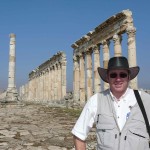
About the Author:
Ralph Ellis is author of Cleopatra to Christ, King Jesus, Mary Magdalene, Princess of Orange. All are available on iPad, Kindle, or Nook. Paperback copies available from Adventures Unlimited of Illinois. See: http://www.edfu-books.com/

